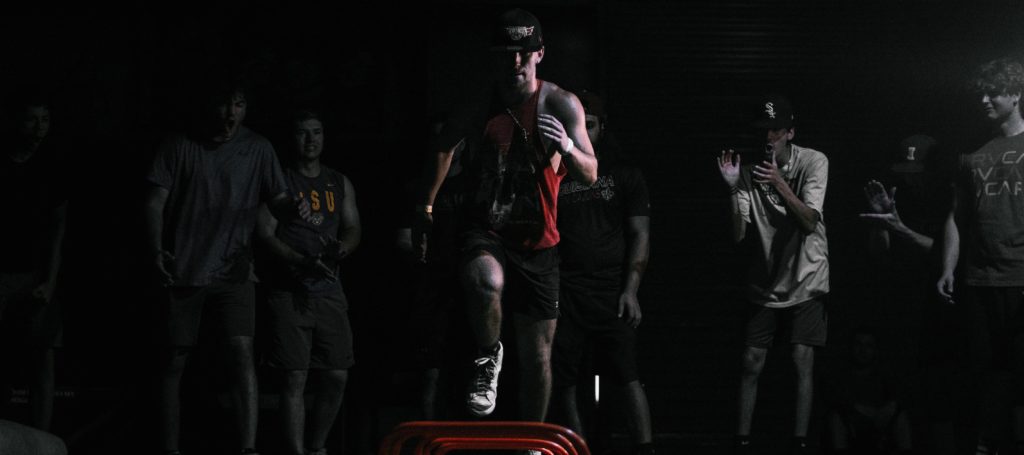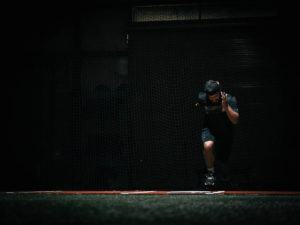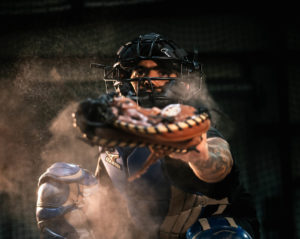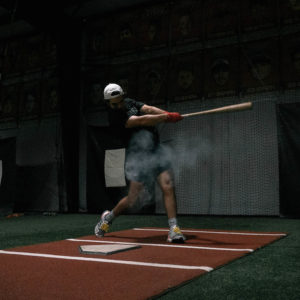
| Skill Test | Pro Level High NCAA D-1 | Low NCAA D-1 Junior College | NCAA D-2/3 Small College |
|---|---|---|---|
| 60 Yard Dash | SS-CF 6.6-6.8 Other 6.8-7.0 | SS-CF 6.8-7.0 Other 7.0-7.2 | SS-CF 7.0-7.2 Other 7.2-7.4 |
| 20 Yard Lateral Break | 2.5-2.6 2.6-2.7 | 2.6-2.7 2.7-2.8 | 2.8-2.9 2.9-UP |
| 40 Yard Turn Time | 5.0-5.1 5.1-5.2 | 5.2-5.3 5.3-5.4 | 5.4-5.5 5.6-UP |
| Home to 1st Base | 4.0-4.2 4.2-4.4 | 4.4-4.6 4.6-4.8 | 4.8-5.0 5.0-UP |
| Infield Glove to Glove | 1.8-2.0 | 2.0-2.1 | 2.2 Up |
| Infield Throwing Velocity | 80 Up | 75-80 | 75 Down |
| Outfield Glove to Glove | 2.0-2.5 | 2.5-3.0 | 3.0 Up |
| Outfield Throwing Velocity | 85 Up | 80-85 | 80 Down |
| Catcher Glove to Glove | 1.8-2.0 | 2.0-2.2 | 2.2 Up |
| Catcher Throwing Velocity | 85 Up | 80-85 | 80 Down |
| Pitcher fastball Velocity | 85 Up | 80-85 | 80 Down |
| Pitcher Breaking Ball Slider Curve | Minus 6-8mph Minus 14-15 mph | Minus 6-8mph Minus 14-15 mph | Minus 6-8mph Minus 14-15 mph |
| Pitcher Change-Up | Minus 16-18 mph | Minus 16-18 mph | Minus 12-14 mph |
| Bat Speed/Hand Strength | 90 mph and up | 85-90 mph | Under 85 mph |
Running Ability
 60 Yard Dash
60 Yard Dash
Run for 60 yards at a speed that represents your running form and stamina. Baseball is not the only sport it applies to. The 60 time is a key indicator of speed for both professional and collegiate scouts. Additionally, it is job-specific, with greater standards for higher-skilled occupations.
20-Yard Lateral Break
This ability assesses the baserunner's 10-step and beginning quickness from first base. In a straight line from first base, the left foot is 15 feet away. The runner crosses a line 15 feet from second base at the start of the initial movement, at which point the timing is recorded. As a result, the runner's sliding ability is no longer a factor. The best test to determine a player's base-steal potential is usually considered to be this drill. Do not slide.
40 Yard Dash
With the left foot on the 30 foot mark, the player begins the 40-yard turn time 30 feet from second base on a straight line from the base. The athlete is timed as he crosses the 30 foot line from home plate while running the turn at third base. This test evaluates your ability to run in a straight line from first to third base and from second to home plate.
Home to First Base
Simulated or timed at-bat contact to first base.
The clocker calculates all times depending on the runner's initial motion. Two tests will be given for each skill.
Defense Baseball Skills
 Glove-to-Glove Time in the Outfield
Glove-to-Glove Time in the Outfield
Each outfielder begins in a grid of 20 feet, with the bask line 200 feet from home plate. The fielder must catch the ball in the square and release it before moving 180 feet past the line. The average of the highest two throws will be recorded after three are made. The glove-to-glove ability measures arm power, throwing accuracy, and mechanics. For a typical runner, 1/10 of a second equals 2 feet of running distance.
Outfield Velocity
Pitchers from the mound are sometimes used to compare the outfielder's arm strength to that of a pitcher. In order to project a player into a left field, center field, or right field position, coaches and professional scouts typically use this skill in conjunction with the 60-yard dash time.
Infielder Glove to Glove Time
All infielders (2B, 3B, SS) take the hand-thrown ball in a 15-square-foot box that corresponds to the typical shortstop position during infielder glove-to-glove time. To establish rhythm and release the ball inside the front edge of the box, each player can advance with the ball. This timed skill is an amalgam of arm power, accuracy, and throwing mechanics. A 15-foot square box with the front boundary marked from first to second base is used by the first baseman to throw to third base. The average of the highest two throws will be recorded after three are made.
Infield Velocity
This metric reflects a player's arm power but is merely one measure of talent. The modern infielder is capable of throwing the ball with a sufficient glove-to-glove time from a range of positions and arm angles.
Catcher Glove-to-Glove
As the pitcher throws from the mound, the catcher is fully engaged in the standard defensive position (or slightly in front). This ability reflects the interaction of throwing technique, arm strength, and accuracy, just like with outfielders and infielders. The average of the highest two throws will be recorded after three are made. Once more, the average runner covers two feet in a tenth of a second.
Catcher Velocity
As the ball reaches the pitching mound, the radar gun is positioned behind the catcher, and the velocity reading is captured. As the ball approaches second base, its velocity typically drops by 4 to 6 mph.
Offensive Baseball Skills
 Bat Speed/Hand Strength
Bat Speed/Hand Strength
This ability is assessed using a batting T placed at home plate in the center of the strike zone. A line drive with a distance of 30 feet must be made to the net between the lines of a triangle grid whose points would be the SS and 2B locations. This static ball test evaluates bat accuracy, bat speed, and hand strength. Many people believe that this test is a better predictor of hitting success at the collegiate and professional levels. Two radar guns should be utilized at the SS and 2B angles for optimal accuracy, with the average score between the two being recorded. Three swings at the very least should be examined. The ball must first touch the net before touching the ground.
Enhance Your Baseball Skills with the TopVelocity Program
Are you looking to increase your baseball abilities? Look nowhere else! When you enroll in the Topvelocity programs, your speed, power, and general performance on the field will all noticeably improve. Don't pass up this chance to get to the top of the game. Join right away




Excellent analysis on measurements for a collage and pro velocity although you are correct on many your college catches velocity for 85 and above is way off ,, if 85 up is the standard for a D1 or pro player right now out of the 81 major league catches only 13 can throw above 85MPH a good high school catcher ( without a crow hop ) can average 75MPH only know of a few one being a class of 2026 catcher @GilliganMickey